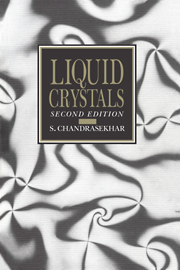3 - Continuum theory of the nematic state
Published online by Cambridge University Press: 08 January 2010
Summary
The Ericksen-Leslie theory
In this chapter we shall discuss the continuum theory of nematic liquid crystals and some of its applications. Many of the most important physical phenomena exhibited by the nematic phase, such as its unusual flow properties or its response to electric and magnetic fields, can be studied by regarding the liquid crystal as a continuous medium. The foundations of the continuum model were laid in the late 1920s by Oseen and Zöcher who developed a static theory which proved to be quite successful. The subject lay dormant for nearly thirty years afterwards until Frank reexamined Oseen's treatment and presented it as a theory of curvature elasticity. Dynamical theories were put forward by Anzelius and Oseen, but the formulation of general conservation laws and constitutive equations describing the mechanical behaviour of the nematic state is due to Ericksen and Leslie. Other continuum theories have been proposed, but it turns out that the Ericksen–Leslie approach is the one that is most widely used in discussing the nematic state.
The nematic liquid crystal differs from a normal liquid in that it is composed of rod-like molecules with the long axes of neighbouring molecules aligned approximately parallel to one another. To allow for this anisotropic structure, we introduce a vector n to represent the direction of preferred orientation of the molecules in the neighbourhood of any point. This vector is called the director. Its orientation can change continuously and in a systematic manner from point to point in the medium (except at singularities).
- Type
- Chapter
- Information
- Liquid Crystals , pp. 85 - 212Publisher: Cambridge University PressPrint publication year: 1992
- 2
- Cited by



